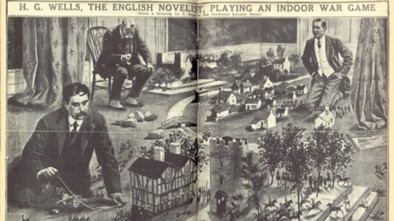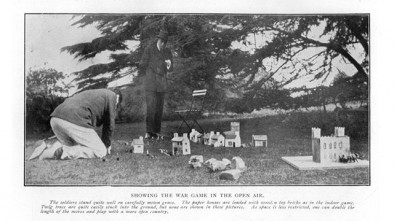Was H.G. Wells the Father of Wargaming?
September 20, 2012 by dracs
Anyone who is a fan of classic science fiction has heard the name of H.G. Wells. From the Invisible Man to the Time Machine, Wells wrote some of the most influential literary works of science fiction. Yet, according to Luke Plunkett of Kotaku.com, his influence may well extend even further, even to the realms of our own beloved hobby.
Some of you may recognise this famous image, a copy of which can be seen outside the Miniatures Hall in Warhammer World, Nottingham. It depicts the famous author engaging in what looks to be quite a large scale war game using toy soldiers and built terrain. Look familiar?
Plunkett's article provides us with a great insight into how our dear hobby was helped along by, not just one, but two great English novelists.
Sitting around after dinner one night with his friend Jerome K. Jerome (author of Three Men in a Boat), the pair began firing a toy cannon at toy soldiers, eventually making an impromptu competitive game out of it. Convinced that with some rules and a little more variety he could make a structured experience of it, Wells - an admirer of Kriegsspiel as a concept - decided to write what would become known as "Little Wars". - Luke Plunkett, HG Wells Practically Invented Modern Tabletop Wargaming, Kotaku
It warms my heart to know that, while Wells was in the process of developing his wargame, he had to face many of the problems which plagued my own first games of Warhammer.
"The soldiers did not stand well on an ordinary carpet", Wells writes, "the Encyclopedia made clumsy cliff-like 'cover', and more particularly the room in which the game had its beginnings was subject to the invasion of callers, alien souls, trampling skirt-swishers, chatterers, creatures unfavourably impressed by the spectacle of two middle-aged men playing with "toy soldiers" on the floor, and very heated and excited about it." - Kotaku
At least he didn't have to put up with a cat which would jump onto the gaming table from the top of a bunk bed, catapulting my Slann Mage-Priest across the room. You will believe a Slann can fly.
The resulting rule system, entitled Little Wars, was a phenomenal success, helping to bring the concept of recreational wargaming to light in society.
Little Wars can still be read over today thanks to Project Gutenberg, so if you want to see how this genesis of recreational gaming holds up today be sure to check it out. Also, if you want to learn more about Wells' gaming experience be sure to check out Luke Plunkett's article over at Kotaku.











































































I really want to say yes to this but Im sure ancient history had examples we dont know about
I secretly think Alexander and Julius etc did wargaming, except they used real people rather than minis 😉
I think it is fair to say Wells was the father of modern wargaming. Even though other games had existed for centuries or even millennia in some form, the practice had all but died except the highly structured and abstracted chess and a few other similar games from other cultures. Little wars was a new genesis in some ways (likely one of several over the ages), though I couldn’t tell you how it caught on that time.
You should have seen the size of the dice!
Rumour has it the Sphinx lost her nose when Julius Caesar was playing with Cleopatra.
No jokes about his dice being cocked, this is a family show.
oh dear
Looks like my attempt at humour was half cocked.
Strategic board games have existed for millenia, but those could hardly be called wargames in the same sense as what Wells was doing. Wells was more inspired by Kriegsspiel and other military training and planning wargames, but even that is significantly more abstract than miniature wargames. It also has no real element of random chance (no dice). The only thing random about Kriegsspiel is the whims of the referee (who is required btw). What Wells did really, was create a fun kind of wargame that could be enjoyed as a leisurely form of entertainment. Everything prior to that was either… Read more »
they used dice for sure “Alea iacta est”
It was a good read, very informative. I just went to look it over and be for I knew it I had read nearly the whole thing. I would say he was the father of the type of wargaming we know today as a hobby. Not something played in war rooms and military academys to teach and test tactics like Kriegspiel.
wasn’t this posted a while back?
You are forgetting about the Time Machine.
It won’t actually be posted until 23rd Feb 2013
Has anyone played Little Wars?
I’ve read the rules, but I don’t anyone who’s played it. For starters, the game requires guns that fire. Seriously, you use spring-loaded toy artillery. Secondly, the whole rule book reads like this: “THE beginning of the game of Little War, as we know it, became possible with the invention of the spring breechloader gun. This priceless gift to boyhood appeared somewhen towards the end of the last century, a gun capable of hitting a toy soldier nine times out of ten at a distance of nine yards. It has completely superseded all the spiral-spring and other makes of gun… Read more »
Maybe like you could translate it to be cool for the L££Tsprach generation.
It’s nice to see we have good company in our past.
Yes but apparently we might also have the lead singer of My Chemical Romance so its not all good.